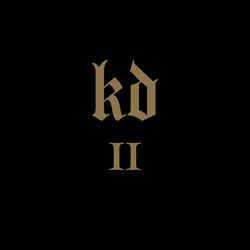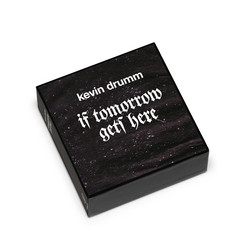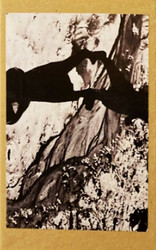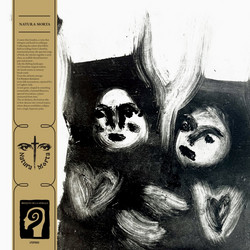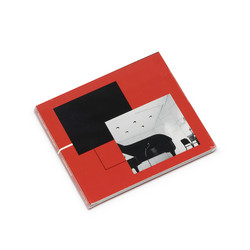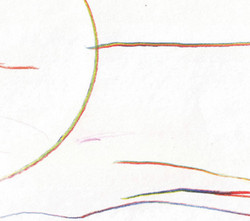Graham Lambkin, Michael Pisaro
Schwarze Riesenfalter
An evocation of “Nacht,” Graham Lambkin and Michael Pisaro’s chilling, malefic collaboration directly references Giraud’s collection of poems, Pierrot Lunaire, and Arnold Schoenberg’s melodrama of the same name. Despite the continental subject matter, Schwarze Riesenfalter isn’t an academic act of re-rendering a historical text. Their use of verse comes across as the result of warped poetic fascination and fixation, where a text crawls underneath skin, finding ways to subtly influence the mundane, whether it be mulled over with coffee or represented within the proudest moments of the artists’ daily practice. It’s easy to see “Nacht” in the work’s track titles, which reference environmental images of night pierced by blasts of light (Leuchtfeuer), clouds of winged creatures (Aufflattern die Fledermäuse), and icy winds thrown against stark, European vistas (Ein easier Wind). Or, perhaps the extent of allusion is found in the conceptual dimension of the titular image of the “Black Butterfly” itself, a sort of simultaneously guiltless and ominous figure that seems more innocent in Giraud’s original french, “Papillons Noir,” more brutal in German “Schwarze Riesenfalter,” and just plain weird in English — “A Giant Black Butterfly.”
Given a tradition of Erstwhile’s “dream” collaborations, an alliance between Pisaro and Lambkin seems essential due to the intersectional and divergent qualities of their compositional styles. For one, Pisaro’s membership in the Wandelweiser group ties him to a quasi-Cagean compositional agenda that values the intentional integration of non-sound and silence into systems that merely present flows of constant sound. Similarly, Lambkin’s approach has often included the economical design, organization, and juxtaposition of diverse sound sources. Both, in their own ways, explore elements of phenomenological contingency, as Lambkin’s sound-sampling takes on unknown semiotic quality given the counterpoint and chance of their sudden relationships, while Pisaro’s heavily mediated scoring develops music’s ability to communicate temporality through controlled experiments happening within measured spans of time. Where Lambkin discusses the pleasure of discovering how Spanish radio leaked into a recorded track, Pisaro pens liner notes prompting instrumentalists to turn on static at specific intervals. Also, interestingly enough, they are both originally guitar players, a fact that inevitably ties them to the instrumental condition of “rocking” and the fantastic sense of humor and melodrama that often comes nicely packaged with the instrument.
The odd couple of the comedic and the darkly absurd is embodied through Giraud and Shoenberg’s Pierrot Lunaire and the music of Schwarze Riesenfalter. The classical Pierrot figure’s macabre lunacy is reified within the serious, disturbed “playfulness” of the album, be it through the “tuning” moment of a vibrating phone or the exasperated phlegm-filled vocalizations on “Zerbrochene Munder.” Whereas Schoenberg aptly captured an essence of “The Fool” in flighty atonal motifs that illustrate a progression from sex and escapade to violence and blasphemy, Lambkin and Pisaro abstract the character into the singular voice of “Nacht” — the character’s vivacity is rendered into a twisted, forlorn setting. Schoenberg’s obscure use of seven-note phrases, a seven member ensemble, and other numerologically significant choices are mirrored in the duo’s unknown choice of symmetrically sequencing track lengths: 4:30, 17:17, 5:30, 17:17, 4:30.
Given the abstract tendencies of both artists, the music itself occasionally represents the accompanying text: it contains a linear, well-paced dramatic structure that involves periods of tension, release, and atmosphere — the semblance of a poetic narrative. Opening piece “Leuchtfeur” has the duo at their most sonically oppressive, as a dirge-like piano is hammered out in the lower register amidst sparkling white room noise. The keys trickle up into gnarled groups, articulating an enshrined space of reverence as the notes fade out into fog. Soon after, we’re given the episodic “Aufflattern die Fledermäuse,” a triumph of a composition that has ascending piano-work surfing though diverse collections of sound material: the comical inclusion of the vibrating phone erupts into clangs of metal and wood, throat singing, owls, and gongs, while razor-sharp arrangements of flute and synthesizer become wrapped in cloaks of digital smoke. I’m also almost completely certain that the preliminary vocalizations are sourced from that one YouTube video with the talking cat saying “no, no, no”… maybe? In any case, the result is entirely entrancing, as the piece keeps its materials relatively visible while leaving the process opaque. Although I can attempt to visualize a composer-ly division of labor, all that’s clear is the towering, breathtaking force of composition. The frigidly digital synth tones of “Ein eisiger Wind” allow for an unsettling meditation that’s well placed to set up the second long-form piece, “Zerbrochene Münder,” a lurching journey that pairs wavering overtones with field recordings of breath and birdsong. Then, a horrifyingly raw human voice pitches a single syllable utterance in near silence.
The complete musical opacity of Schwarze Riesenfalter is an asset that lends itself well to the temporally fluid experience of listening to its overwhelmingly diverse collection of sound-sources. Although there are accompanying historical reference points, the work is a singular entity that demonstrates how a text can seed memory and experience to develop anti-narratives that are laterally situated to a given referent. Yes, we vaguely see Giraud and Schoenberg in the duo’s murky exploration, but perhaps more, we see how a text can become warped and infinitely rearranged within the limitlessly contingent aspects of perception. Pulling out clear answers from a piece this cataclysmically obtuse feels like digging up strangely eroded black stones from the mud of a riverbed. Maybe it’s best to consider the piece as clouded as the nature of collaboration itself; creative communication can force contingency, given that one must respond to the perceptual apparatus of another working mind. The music becomes irreconcilably determined by the unknown interiority of the collaborator, as infinite combinations of independence and cooperation formulate strange new forms. This spirit of liminality forms the essence of experiencing Schwarze Riesenfalter — a space between light and dark, where midnight brooding helps to welcome a more light-hearted, mystical type of moment with the potential for the wandering soul to “experiment” with devastation. The moment where a text becomes your own warped narrative — The Fool, The (Giant) Black Butterfly, Black Stones, A Riverbed, The King…Mouths, “Nacht.” (TinyMixTape)

